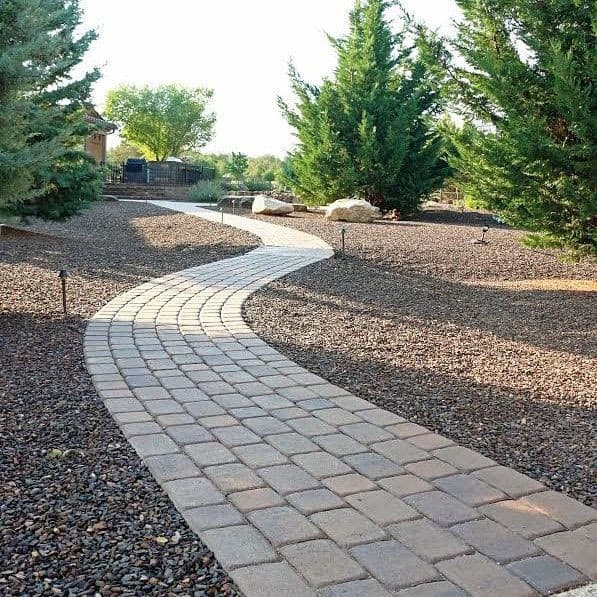Welcome From Vikings Masonry, Block, Concrete and Turf Professionals.
Home » Walkways


Walkways serve as a means of transportation for people in both residential and commercial properties, which is why we specialize in masonry walkways at Vikings Masonry & Turf.
Walkways promote healthy living by providing an inviting reason for people to spend time walking during the evening or morning. They also guide pedestrian traffic and act as guides to where people should go. They can also contribute to the overall aesthetic appeal of a property, making them an essential part of the design.
That’s why the design of a walkway is a crucial consideration. However, besides the actual design, it’s also important to think about the specific type of walkway pavers that will be used for outdoor spaces. Fortunately, there are now many options available for homeowners and paving contractors to choose from.
Some ideal paver options include concrete pavers, bricks, and natural stones, each offering exciting benefits.
For example, natural stone walkway pavers are perfect for those who want to achieve a more natural look and feel. However, since they are not man-made, you may need to settle for what is available.
On the other hand, with brick and concrete pavers, there is a wide range of colors, textures, and shapes to choose from, making it easy to achieve a customized look.
In summary, you can choose from shapes such as turf block, Holland, hexagonal, cobblestone, interlocking, uni-theme, Cambridge, and marquise.
It’s worth noting that landscape architects, designers, and builders sometimes make a distinction between the terms walkway and pathway. Walkways are functional paved surfaces used to facilitate foot traffic and are often straight routes, made from hard paving materials. A pathway, on the other hand, is a more recreational feature of a landscape, a meandering route, often made from casual, rustic materials. Pathways are suitable for more natural settings, such as gardens, where they provide a means for enjoying landscape features at leisure. Walkways, on the other hand, tend to be more practical, designed to move people from point A to point B with minimal fuss.
Differences Between Walkways and Pathways
Walkways and pathways are often constructed using different materials. Pathways are often made of natural materials such as loose gravel or mulch, whereas walkways are typically made of durable hardscape materials like poured concrete, large slabs of mortared stone, or pavers.
Pavers are a preferable choice for walkways over poured concrete as they have a more natural appearance and are available in various earth tones for better integration into the landscape. They are also less prone to cracking and if damaged, can be easily removed and replaced.
Another key difference between walkways and pathways is their width, walkways are generally wider, typically four to six feet, to allow for pedestrians to pass each other, while pathways are usually narrower, two to three feet wide, as they are used less frequently and by fewer people.
Design Considerations for Walkways and Pathways
It is important to maintain a cohesive design for walkways. If you have a traditional home, symmetrical lines may be the best option. For a country-style home, large flagstones can give a more natural look. Homeowners should consider factors such as weather conditions and intended usage for the walkway or path when discussing the project with their landscaper, as it will aid in determining the most suitable design for their space.
Design Trends
In walkway construction, acid staining and stamping concrete have recently become very popular trends, offering cost-effective ways to beautify regular poured concrete. However, these methods will not last forever and often require yearly maintenance. Acid stains can be applied to pre-existing concrete, making this a cost-effective option for homeowners seeking to renovate existing concrete walkways. Acid staining is sometimes done successfully by DIYers.
Another method of coloring concrete is dyeing. There are roughly 40 to 50 concrete dye colors from which to choose, but this process is most effective when it is mixed into large batches in a ready-mix truck. Large-scale dyeing is not practical for the DIYer. Stamping concrete is also best done by professionals.
When choosing a color for stained or dyed concrete, match the walkway with the color of the house. Often, earth-tone colors provide a nice complement to the home’s exterior. When designing a pathway, make sure the colors are natural and blend with the surroundings.
To maintain a good appearance when stamping or dyeing concrete, use a commercial sealer after completion. You can choose either a glossy or a dry look to enhance the color. A commercial sealer can also prevent mold and mildew buildup and help prevent weather from breaking down materials.
Planning Considerations
Several issues should be considered when choosing materials for a walkway or pathway:
Budget. The budget a homeowner has set aside for the project is the largest factor when selecting materials for a walkway or pathway, as cost dictates what materials are available to use.
Shade. The amount of shade present is another determining factor when deciding which materials to use in walkways and pathways. Moss and mildew will accumulate on stone and concrete, causing a slippery, hazardous condition. Use trail mix—a natural mixture of aggregates—for pathways in shady areas for pathways. For walkways in shade, use pavers rather than poured concrete.
Home construction. Look at the house’s colors and siding. Is it brick? Stucco? Wood siding? When developing a walkway, try to select a color that complements existing structures, but doesn’t match them exactly. For example, if your home has a brick exterior, select one tint found in the brick walls to include in the walkway. This is why earth tones are so popular—because they often complement traditional building materials. For pathways, this isn’t as difficult because you are often placing the pathway in a very natural setting between trees or a garden. Shredded wood, gravel, and other natural materials often work best in these situations.
We provide high-quality, durable travertine pavers that are stronger than most concrete products and require no maintenance. With our pavers, you can enjoy a simple and lasting solution that can withstand even the most extreme temperatures. Installation is easy as our pavers fit together seamlessly without the need for sand. The end result is a non-slip, heat-resistant surface that will save you time and money without sacrificing quality or aesthetics. With a wide range of patterns and colors to choose from, our travertine pavers are perfect for outdoor spaces such as pool decks and walkways. And with minimal maintenance and lower cost compared to other paving materials, travertine pavers are an excellent choice for any project. If you need a professional travertine paver installation in Arizona, please contact Vikings Masonry Company.
Save money without sacrificing quality or style
Our goal is to provide you with the stylish appearance you desire. We offer durable Travertine pavers that will provide long-lasting quality. These pavers are ideal for protecting children’s feet from excessive heat and reducing the risk of slips.
Get powerfully brilliant results in no time
Enjoy fast, hassle-free installation with pavers that fit together close to perfect without the need for sand.
Beauty and quality all in one
We take pride in providing exceptional results that are visually appealing without compromising on quality or materials.
Travertine pavers may not be as well-known as other materials such as block and stone, but they are viable alternatives. Like rocks, travertine is a sturdy material. The Colosseum, one of the most well-preserved ancient Roman structures in the world, is mostly constructed with travertine. Additionally, travertine maintains its color even when exposed to fluctuating weather conditions, which is particularly useful in Arizona’s extreme heat!
In addition, travertine pavers are a great choice for areas where safety is a concern. In Arizona, many of our travertine pavers are installed around pools as pool decks and yard walkways. Travertine comes in various exciting patterns, which can catch people’s attention and admiration. You can choose from patterns such as basket weave, fish, mosaic, French, diamond cut, star, herringbone, and many more. The available colors include beige, ivory, pecan, pink or peach, red, yellow, and so on. Additionally, there are various finishes you can choose from such as tumbled, antique, and honed.
Furthermore, travertine is a great border material that can add the perfect finishing touch to your project. You can choose from border designs such as shells, rope, wicker, stars, scroll, gothic, art deco, wrought iron, and other unique options.
Additionally, you can select from traditional, old world, modern and contemporary themes to achieve your desired results. All these options are perfect for those who desire a personalized look.
Travertine pavers require minimal maintenance and are more cost-effective compared to other paving materials. Additionally, travertine is a versatile material that can meet all your paving needs, regardless of their size.
On the off chance that you need an expert travertine paver organization in Arizona to help introduce your new yard or pool deck, make certain to call Vikings Masonry Company!
We really care about you and your products as much as you do. Please send us a message for any question.
We deal in great quality products. Our clients are 100% satisfied by our work
Our clients are 100% satisfied by our services
Click here to request a bid
+1 (844) 680-1515
100% Saftisfaction
Copyright © 2021 libertypaversaz | All Rights Reserved